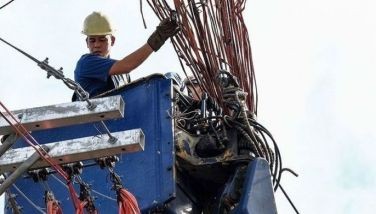Research consortium for ARMM pushed
January 21, 2001 | 12:00am
KABACAN, North Cotabato — It’s high time the Autonomous Region of Muslim Mindanao (ARMM) had its own research and development (R&D) consortium.
The presence of a research mechanism that charts and oversees an R&D program for the region would go a long way to broadening the agricultural and rural development of ARMM, it was pointed out by leaders of the national agriculture and resources research and development network (NARRDN).
A research and development consortium is an arrangement whereby R&D institutions in a given region jointly plan and administer programs, projects, and activities. It provides the mechanism for sharing limited resources in the region.
A consortium is an organization of equals wherein each member can present its programs and avoid duplication (and thus save time and resources) by discussing issues and agreeing for mutual benefits.
Member institutions of varying strengths in different disciplines or areas complement their efforts and thereby achieve a formidable combination of strengths.
As designed by the Los Baños-based Philippine Council for Agriculture, Forestry and Natural Resource Research and Development (PCARRD) of the Department of Science and Technology (DOST), the consortium model serves the purpose of exchanging research information and sharing resources.
Regionalization of the PCARRD-coordinated NARRDN started as early as 1975 when the organization of regional centers and stations into consortia was instituted.
The La Granja Agricultural Research Center (LGARC) in La Granja, Negros Occidental, was created on June 20 that year. Three agencies located in adjacent areas, namely: Bureau of Plant Industry-La Granja Experiment Station, Bureau of Animal Industry-La Granja Stock Farm, and Philippine Sugar Institute (now Sugar Regulatory Administration) signed a memorandum of agreement with PCARRD integrating their operations and agreeing to share with one another their laboratories, farm equipment, facilities, and other resources.
Later, research centers and stations in other regions followed with the same objectives and also entered into consortium arrangements with nearby research stations.
Over the past quarter of a century, the consortium system grew into a family of 14 well-knit and viable regional R&D groups working closely together to boost agricultural and rural development within their respective areas of service.
The consortia are mostly composed of state colleges and universities and agencies under the Department of Science and Technology, Agriculture (DA), Environment and Natural Resources (DENR), and Trade and Industry (DTI), and National Economic and Development Authority (NEDA).
Of the R&D consortia, six are in Luzon, three are in the Visayas, and five are in Mindanao.
The presence of a research mechanism that charts and oversees an R&D program for the region would go a long way to broadening the agricultural and rural development of ARMM, it was pointed out by leaders of the national agriculture and resources research and development network (NARRDN).
A research and development consortium is an arrangement whereby R&D institutions in a given region jointly plan and administer programs, projects, and activities. It provides the mechanism for sharing limited resources in the region.
A consortium is an organization of equals wherein each member can present its programs and avoid duplication (and thus save time and resources) by discussing issues and agreeing for mutual benefits.
Member institutions of varying strengths in different disciplines or areas complement their efforts and thereby achieve a formidable combination of strengths.
As designed by the Los Baños-based Philippine Council for Agriculture, Forestry and Natural Resource Research and Development (PCARRD) of the Department of Science and Technology (DOST), the consortium model serves the purpose of exchanging research information and sharing resources.
Regionalization of the PCARRD-coordinated NARRDN started as early as 1975 when the organization of regional centers and stations into consortia was instituted.
The La Granja Agricultural Research Center (LGARC) in La Granja, Negros Occidental, was created on June 20 that year. Three agencies located in adjacent areas, namely: Bureau of Plant Industry-La Granja Experiment Station, Bureau of Animal Industry-La Granja Stock Farm, and Philippine Sugar Institute (now Sugar Regulatory Administration) signed a memorandum of agreement with PCARRD integrating their operations and agreeing to share with one another their laboratories, farm equipment, facilities, and other resources.
Later, research centers and stations in other regions followed with the same objectives and also entered into consortium arrangements with nearby research stations.
Over the past quarter of a century, the consortium system grew into a family of 14 well-knit and viable regional R&D groups working closely together to boost agricultural and rural development within their respective areas of service.
The consortia are mostly composed of state colleges and universities and agencies under the Department of Science and Technology, Agriculture (DA), Environment and Natural Resources (DENR), and Trade and Industry (DTI), and National Economic and Development Authority (NEDA).
Of the R&D consortia, six are in Luzon, three are in the Visayas, and five are in Mindanao.
BrandSpace Articles
<
>
- Latest
- Trending
Trending
Latest
Trending
Latest
Recommended
























